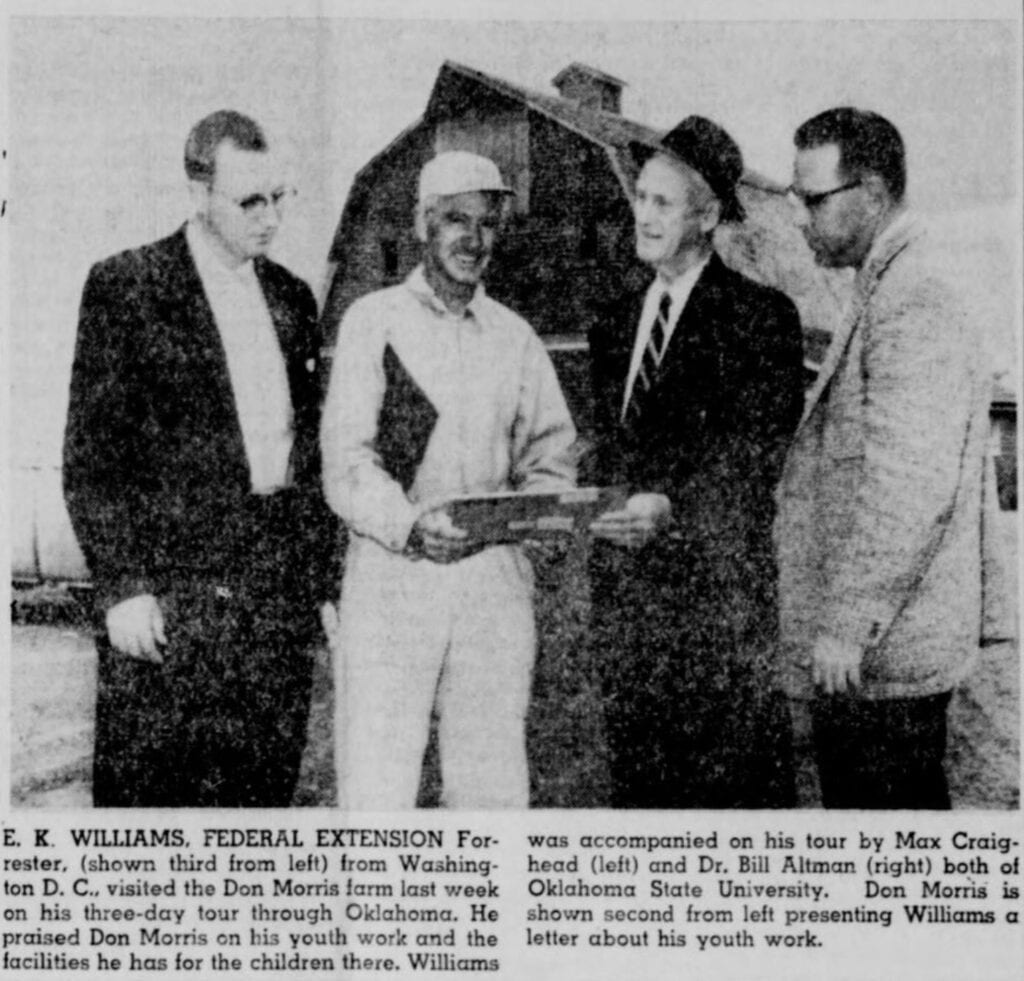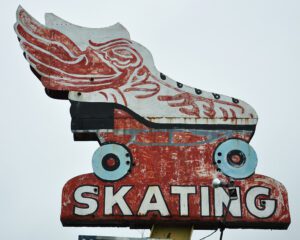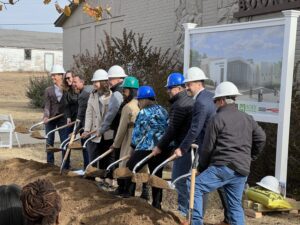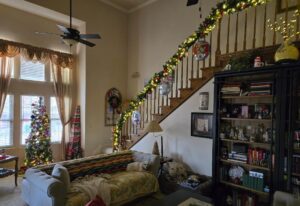When I was growing up here in Sapulpa there was no public swimming pool. Our “swimming hole” was Don’s Marineland, located northwest of Sapulpa on Sahoma Lake Road.
It was owned and operated by Don Morris, a local teacher, coach, and successful entrepreneur.

Don Morris, second from the left, is shown presenting E.K. Williams , third from the left, a letter about his youth work. Williams is the Federal Extension Forester from Washington D.C. who visited Morris on a tour through Oklahoma. On the left is Max Craighead and on the far right is Dr. Bill Altman, both of Oklahoma State University. Photo courtesy of the Democrat News
This local recreational icon had once been home to Woosey Deere, a legendary Creek woman who became quite wealthy from oil.
The Morris “farm” was a 250-acre tract of land divided by the Turner Turnpike. There were four lakes/ponds utilized for fishing and one spring-fed swimming lake. The swimming lake was behind a beautiful red brick house that locals used to call the Woosey Deere Mansion. There was a barn that had advertising on the roof.
The swimming facility was fully equipped for its day. It featured a diving board, slide, wooden raft, and old truck tire innertubes as flotation devices.
A number of people have said they learned to swim out there, and certainly, vast numbers of youngsters and teenagers swam at Don’s Marineland.
The teenage girls, for the most part, went there to flirt more than swim. I remember seeing the older girls in bikinis lying on blankets with suntan oil and transistor radios. It was the small-town version of “going to the beach.”
There was a lifeguard on duty to rescue swimmers in distress. David Lawrence said he was grateful that Frances Spears was on the job one fateful afternoon. “I was in there swimming one day and got too far out, and I don’t know what happened, but I got tickled, got to laughing, and couldn’t stop laughing. I tried to make it back and I couldn’t make it. He ran out there and jumped out and saved me and pulled me back. You don’t forget people who saved your life.”
Ross Rainwater shared his experiences out at the local aquatic hangout.
“I didn’t learn how to swim until about the fourth grade maybe, I had a great fear of water, and I learned to swim, finally. I went out, somewhere along the line, with John Harper, a classmate of mine, and probably my best friend in life, with somebody else…I remember John and the other guy dived in and swam across the thing. I thought, now, I am not doing that, I was trying to be careful. I was comforted by the fact that they had these enormous truck tire tubes that he provided. They were fun to swim to and hang onto.”
Since this was not a treated swimming pool Rainwater said he always thought to himself, “I wonder what critters are in it?”
He fondly recalls seeing the daughter of a local car dealership drive up in a new Toronado and noticed that when she stepped out of the vehicle she was wearing a bikini.
“I thought, ‘holy mackerel,’ this gal has really blossomed. I remember I took an instant interest. She filled out a bikini real well.”
Fishing and hunting was offered on other parts of the property. David Lawrence remembers fishing there with his father. Morris had a dedicated spot for handicapped people to fish.
Scouts, schools, churches, and other organizations had access to the facilities for meetings and camping.
Don Morris was a consummate businessman. Besides Marineland, he and his wife Marian opened the Sahoma Motel and Restaurant in 1951. He bought, built, and sold houses, and he and a business partner built the Sapulpa Nursing Home at the Southwest corner of Mission Street and Hobson Avenue which opened in 1957.
He was recognized as the largest catfish farmer in Oklahoma. He was also quite a horticulturist. He grew tomatoes “the size of footballs.”
Don Morris was active in the community, promoting youth programs. He sponsored the “Sapulpa Alumni Youth Club” which was an organization that provided vocational and personal guidance to youth. The club also encouraged and developed them to become good citizens.
During the fall and winter months, Morris taught classes in fishing, rifle safety, boating, nature studies, health, and physical fitness. He taught Sunday School at the First Baptist Church and on Sunday afternoons he led a Bible study group. Morris was a teacher for half a century and a Sunday School teacher for 45 years.
In 1961, Federal Extension Forester, W.K. Williams, along with OSU officials, toured the Morris farm. Williams praised Morris for his youth work and his recreational facility for kids. Morris also received a letter of appreciation from the U.S. government.
Morris eventually sold the property, and a few years later, died at the age of 81 in 1987.










